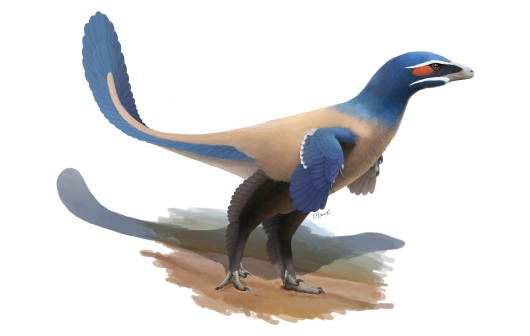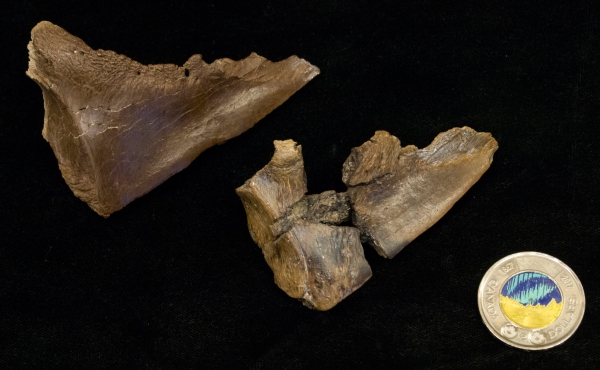Currie’s Alberta Hunter
Today, my research group published a paper identifying and naming a new species of troodontid dinosaur in honour of Dr. Philip J. Currie. Albertavenator curriei, meaning “Currie’s Alberta hunter”, stalked Alberta, Canada, about 71 million years ago in what is now the Red Deer River Valley. The find recognizes Currie for his decades of work on predatory dinosaurs of Alberta. The paper was co-authored by University of Toronto PhD students and lab members Thomas Cullen and Derek Larson, as well as one of my undergrad students Adam Rego. Our research on the new species was published on July 17 in the Canadian Journal of Earth Sciences.

Life reconstruction of Albertavenator curriei by Oliver Demuth.
The bones of Albertavenator were found in the Horseshoe Canyon Formation, in the badlands surrounding the Royal Tyrrell Museum, which Dr. Currie played a key role in establishing in the early 1980s. The rocks around the museum are the same age as some of the most fossiliferous rocks in the area of the newly erected Philip J. Currie Museum, also named in Currie’s honour. Phil has already has several dinosaurs named after him, and this is the second one from Alberta, where he has made his biggest impact. Its widely known in the palaeontological community that Phil’s favorite type of dinosaur is Troodon (hence the logo for the new P. J. Currie Museum). Albertaventator becomes the third troodontid named after him- Liaoningvenator curriei came out while our paper was in press.
We based Albertavenator on two partial skull bones, and feel its likely that a dentary from the same formation belongs to the same species. This doesn’t sound like much- and its not- but its the only troodontid skull material from the Horseshoe Canyon, and some of the most diagnostic troodontid material from the entire Maastrichtian of North America. Other than teeth, troodontid fossils are very, very rare in twilight of the Cretaceous in North America. In preliminary assessments, palaeontologists believed that the fragmentary bones of Albertavenator belonged to its close relative Troodon, which lived around 76-million-years-ago — five million years before Albertavenator. Both dinosaurs walked on two legs, were covered in feathers, and were about the size of a person. New comparisons of bones forming the top of the head reveal that Albertavenator had a distinctively shorter and more robust skull than Troodon, its famously brainy relative.

The holotype frontal bone of Albertavenator curriei, showing the brain cavity.
Identifying new species from fragmentary fossils is a challenge. The delicate bones of these small feathered dinosaurs are very rare. We were lucky to have a critical piece of the skull- frontal bones (the bones that form our forehead), that allowed us to distinguish Albertavenator as a new species. The identification of a new species of troodontid in the Late Cretaceous of North America indicates that small dinosaur diversity during this well studied time period is likely underestimated due to the difficulty of identifying species from fragmentary fossils. It was only through our detailed anatomical and statistical comparisons of the skull bones that we were able to distinguish between Albertavenator and Troodon. The work confirms previous predictions by Lindsay Zanno and Tony Fiorillo that the diversity of troodontids in the Late Cretaceous of North America in particular is underestimated due to over-synonymization of fragmentary, generally non-diagnostic material.
Complicating matters of this new find are the hundreds of isolated teeth that have been found in Alberta and previously attributed to Troodon. Teeth from a jaw that likely pertains to Albertavenator appears very similar to the teeth of Troodon, making them unusable for distinguishing between the two species. Our morphometric study of troodontid teeth from the latest Cretaceous of North America strongly suggests that the holotype tooth (yes, a single tooth) of Troodon formosus is not valid to the species level- but more work will need to be done to confirm this, so we didn’t formally sink everyone’s favorite brainy dinosaur. Ultimately, more complete specimens from the Judith River Formation are needed to resolve this issue.

Comparison of frontals of ‘Troodon’ inequalis (left) and Albertavenator curriei (right).
The fossils of Albertavenator were found in the early 1990s and studied in the collections of the Royal Tyrrell Museum. This is another example of a new species of dinosaur being discovered by re-examining museum research collections, which continually add to our understanding of evolution of life on Earth. This study suggests that more detailed studies of fragmentary fossils may reveal additional, currently unrecognized, species.
Read the paper here.
Full Reference:
Evans, D.C., Cullen, T.M., Larson, D.W., and Rego, A. “A new species of troodontid theropod (Dinosauria: Maniraptora) from the Horseshoe Canyon Formation (Maastrichtian) of Alberta, Canada.” Canadian Journal of Earth Sciences Early Online: 813-826. DOI: dx.doi.org/10.1139/cjes-2017-0034